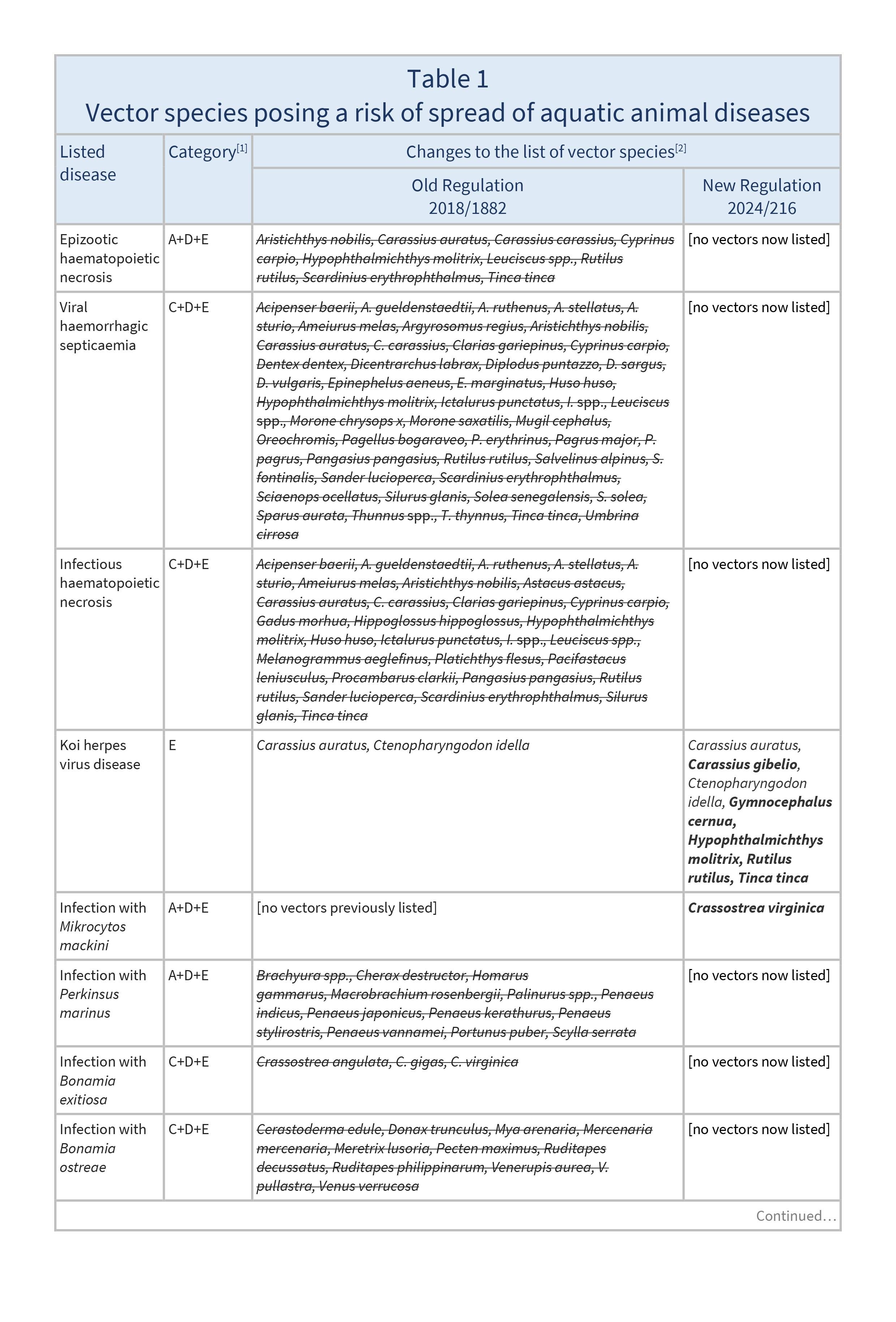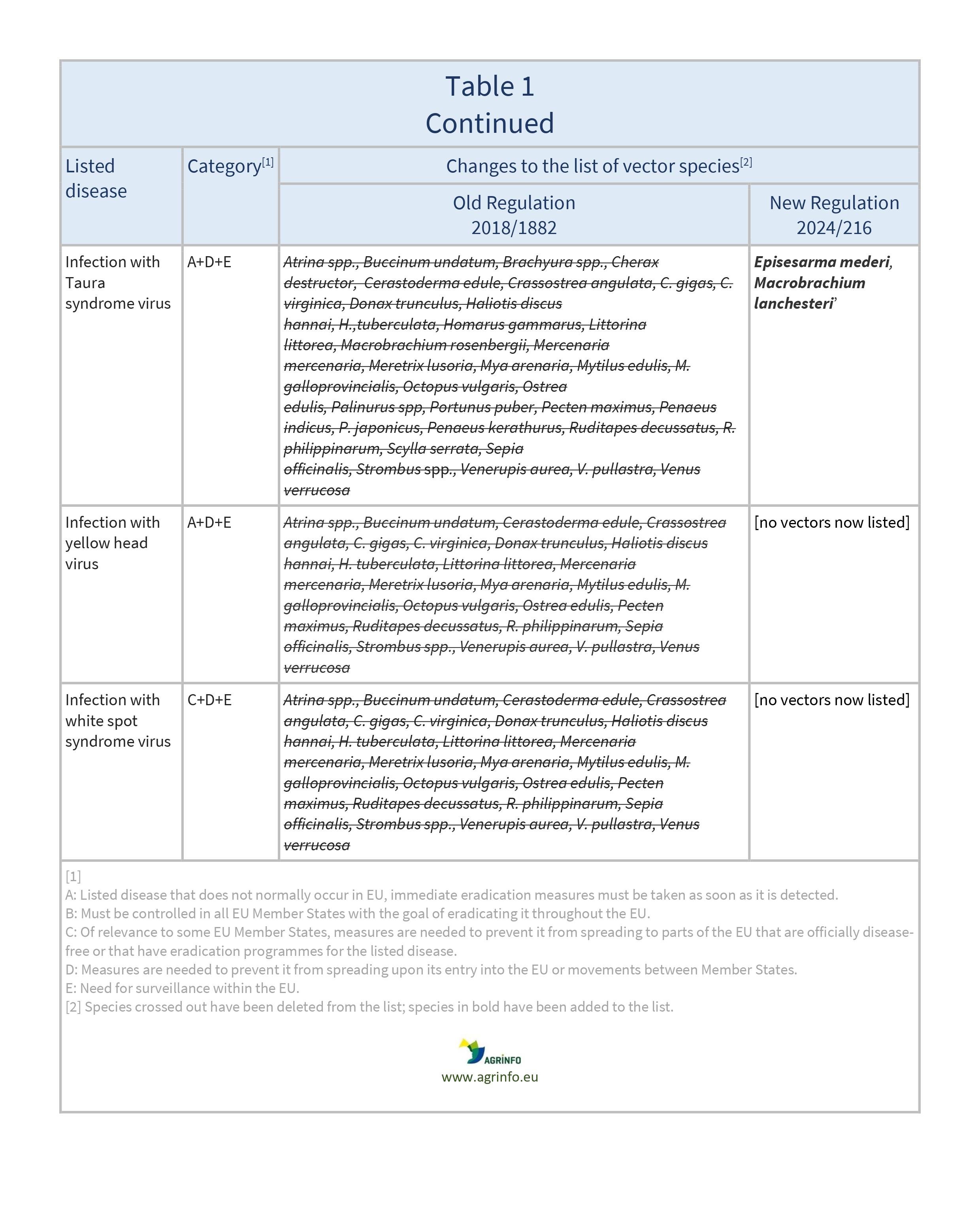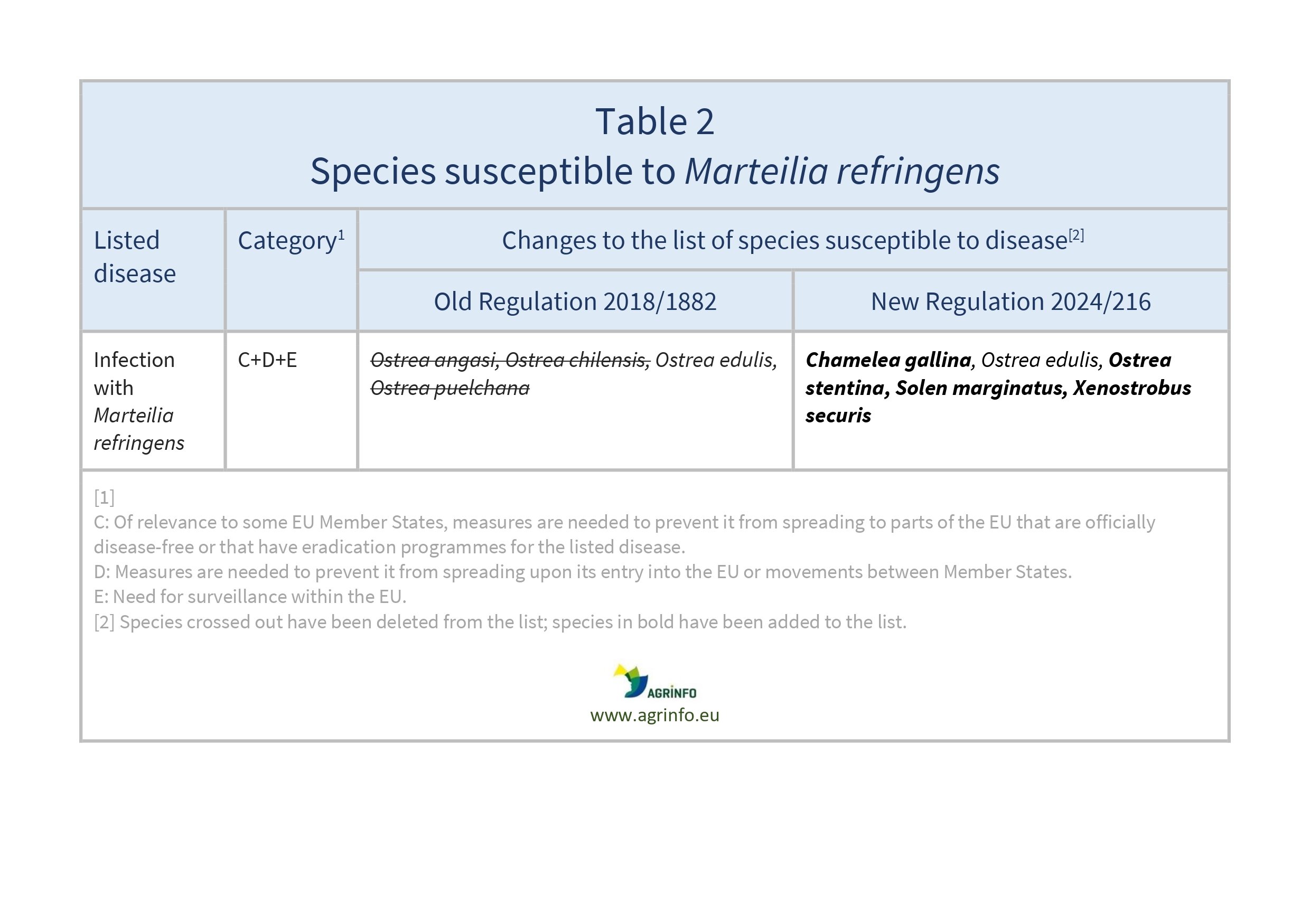Species and groups posing a risk of spread of aquatic animal diseases
- Animal diseases
Summary
The European Commission has updated the list of vectors of aquatic diseases, and has revised the list of aquatic species susceptible to infection with Marteilia refringens.
EU updates lists of aquatic disease vectors, and of species susceptible to Marteilia refringens
Commission Implementing Regulation (EU) 2024/216 of 11 January 2024 amending the Annex to Implementing Regulation (EU) 2018/1882 concerning listed diseases of aquatic animals and the list of species and groups of species posing a considerable risk for the spread of those listed diseases
Update
The European Commission has updated the list of vectors of aquatic diseases, and has revised the list of aquatic species susceptible to infection with Marteilia refringens.
Impacted Products
food-producing aquatic animals
What is changing?
The EU has updated the list of vectors of aquatic diseases, listing only those vectors with a demonstrated ability to transmit these diseases to susceptible species (Table 1).
The EU has also included dwarf oysters, European flat oysters, European razor clams, golden mussels, and striped venus clams in the list of aquatic molluscs susceptible to infection with the protozoan parasite Marteilia refringens (Table 2).
Why?
Regulation 2016/429 requires that the list of vectors of aquatic diseases (set out in the Annex to Regulation 2018/1882) comprises those animal species or groups that pose a considerable risk for the spread of specific listed diseases.
The European Food Safety Authority (EFSA) defines vector species as those species that clearly present such a risk because they have been demonstrated to transmit the causative agent of the disease to susceptible species. Species that EFSA could not demonstrate were vectors have been deleted from the list (EFSA 2023a, 2023b, 2023c). The changes are detailed in Table 1.
The World Organisation for Animal Health (WOAH) has revised its list of species susceptible to infection with Marteilia refringens (Aquatic Animal Health Code, Article 11.4.2). This new EU Regulation seeks convergence with the WOAH standards.
Timeline
The new Regulation applies from 1 February 2024.
What are the major implications for exporting countries?
Risk of transmission of these diseases primarily applies during or after transport of live vectors or susceptible species that may have been exposed to these pathogens. M. refringens can only be transmitted by copepods as intermediate hosts (EFSA 2023b).
Recommended Actions
Fishery operators and exporters to the EU of any vector or species susceptible to aquatic diseases listed in the Annex to Regulation 2024/216 should consider treatment or processing in accordance with good manufacturing practices prior to export, and ensure handling of the products does not jeopardise their safety.
Background
Regulation (EU) 2016/429 lays down rules for the prevention and control of diseases that are transmissible to animals or humans, including rules for prioritising and categorising listed diseases.
Species and groups of species that are susceptible to aquatic diseases and can transmit such diseases are listed in the Annex to Implementing Regulation 2018/1882. The EU frequently reviews this list to ensure that it reflects the latest scientific knowledge, seeking convergence with WOAH standards.
Resources
EFSA (2023a) Species which may act as vectors or reservoirs of diseases covered by the Animal Health Law: Listed pathogens of fish. EFSA Journal, 21(8): 8174.
EFSA (2023b) Species which may act as vectors or reservoirs of diseases covered by the Animal Health Law: Listed pathogens of molluscs. EFSA Journal, 21(8): 8173.
EFSA (2023c) Species which may act as vectors or reservoirs of diseases covered by the Animal Health Law: Listed pathogens of crustaceans. EFSA Journal, 21(8): 8172.
WOAH (2022). Report of the WOAH ad hoc Group on susceptibility of mollusc species to infection with OIE listed diseases.World Organisation for Animal Health.
WOAH: Aquatic Code Online Access.
Commission Implementing Regulation (EU) 2018/1882 on the application of certain disease prevention and control rules to categories of listed diseases and establishing a list of species and groups of species posing a considerable risk for the spread of those listed diseases
Regulation (EU) 2016/429 on transmissible animal diseases and amending and repealing certain acts in the area of animal health (Animal Health Law)
The Commission has set up an information system gathering commercial designations recognised in the EU and other information, such as scientific name, production method and catch area. Only the national lists are authoritative for commercial designations accepted in the member states.
Sources
Commission Implementing Regulation (EU) 2024/216 concerning listed diseases of aquatic animals and the list of species and groups of species posing a considerable risk for the spread of those listed diseases
Disclaimer: Under no circumstances shall COLEAD be liable for any loss, damage, liability or expense incurred or suffered that is claimed to have resulted from the use of information available on this website or any link to external sites. The use of the website is at the user’s sole risk and responsibility. This information platform was created and maintained with the financial support of the European Union. Its contents do not, however, reflect the views of the European Union.
EU updates lists of aquatic disease vectors, and of species susceptible to Marteilia refringens
Commission Implementing Regulation (EU) 2024/216 concerning listed diseases of aquatic animals and the list of species and groups of species posing a considerable risk for the spread of those listed diseases
What is changing and why?
The EU has updated its list of vectors of aquatic diseases, listing only those vectors with a demonstrated ability to transmit these diseases to susceptible species according to the European Food Safety Authority. The list in the Annex to Regulation 2018/1882 will be updated accordingly (Table 1).
The EU has also included dwarf oysters, European flat oysters, European razor clams, golden mussels, and striped venus clams in the list of aquatic molluscs susceptible to infection with the protozoan parasite Marteilia refringens (Table 2).
Actions
Fishery operators and exporters to the EU of any vector or species susceptible to aquatic diseases listed in the Annex to Regulation 2024/216 should consider treatment or processing in accordance with good manufacturing practices prior to export, and ensure handling of the products does not jeopardise their safety.
Timeline
The new Regulation applies from 1 February 2024.
Disclaimer: Under no circumstances shall COLEAD be liable for any loss, damage, liability or expense incurred or suffered that is claimed to have resulted from the use of information available on this website or any link to external sites. The use of the website is at the user’s sole risk and responsibility. This information platform was created and maintained with the financial support of the European Union. Its contents do not, however, reflect the views of the European Union.



